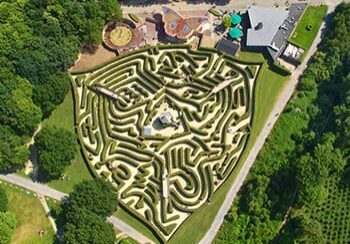
The Blueberry Maze
We all love the taste of blueberries and there's nothing more fun and creative than to turn your seasons of Blueberry harvesting into a large maze to go through enjoy as you pick your blueberries!

wild Blueberries
Many species of blueberries grow wild in North America, including Vaccinium myrtilloides, V. angustifolium and V. corymbosum, which grow on forest floors or near swamps.
Wild blueberries reproduce by cross pollination, with each seed producing a plant with a different genetic composition, causing within the same species differences in growth, productivity, color, leaf characteristics, disease resistance, flavor, and other fruit characteristics. The mother plant develops underground stems called rhizomes, allowing the plant to form a network of rhizomes creating a large patch (called a clone) that is genetically distinct. Floral and leaf buds develop intermittently along the stems of the plant, with each floral bud giving rise to 5–6 flowers and the eventual fruit. Wild blueberries prefer an acidic soil between 4.2 and 5.2 pH and only moderate amounts of moisture.
They have a hardy cold tolerance in their range in Canada and northern United States. Fruit productivity of lowbush blueberries varies by the degree of pollination, genetics of the clone, soil fertility, water availability, insect infestation, plant diseases and local growing conditions. Wild (lowbush) blueberries have an average mature weight of 0.3 grams (1⁄128 oz).
lowbush Blueberries
Lowbush blueberries, sometimes called "wild blueberries", are generally not planted by farmers, but rather are managed on berry fields called "barrens". Cultivated highbush blueberries prefer sandy or loam soils, having shallow root systems that benefit from mulch and fertilizer. The leaves of highbush blueberries can be either deciduous or evergreen, ovate to lanceolate, and 1–8 cm (1⁄2–3+1⁄4 in) long and 0.5–3.5 cm (1⁄4–1+3⁄8 in) broad. The flowers are bell-shaped, white, pale pink or red, sometimes tinged greenish.
The fruit is a berry 5–16 mm (3⁄16–5⁄8 in) in diameter with a flared crown at the end; they are pale greenish at first, then reddish-purple, and finally uniformly blue when ripe. They are covered in a protective coating of powdery epicuticular wax, colloquially known as the "bloom". They generally have a sweet taste when mature, with variable acidity. Blueberry bushes typically bear fruit in the middle of the growing season: fruiting times are affected by local conditions such as climate, altitude and latitude, so the time of harvest in the northern hemisphere can vary from May to August.






